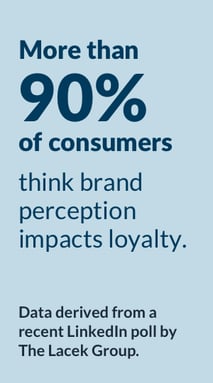For Brands, Perception Is Reality


Positive brand perception—how customers and potential customers view a brand and its values—remains a vital component of building long-term loyalty. Consumers crave brands that are in sync with their own personal core values—and expect brands to consistently live up to those values.
To illustrate, a 2022 Harris poll revealed that 82% of shoppers want a brand’s values to align with their own. A large majority (75%) of those surveyed reported jettisoning a brand over a conflict in values.
Consumers’ perception of a brand can shift quickly, however, after a major incident—or even a minor misstep that goes viral. In the age of social media, where information spreads rapidly and is archived indefinitely, brands must live up to their values and respond to any criticism authentically and transparently.
Brands that are successful in forging deeply rooted emotional connections with their customers are better positioned to withstand criticism in the event of a crisis. They’re also set up to benefit from lasting customer loyalty and engagement.
Let’s explore the benefits of, and best practices for, creating lasting positive brand perception.
Prioritize relationships over transactions
Focusing on relationships rather than transactions provides positive consumer experiences that build loyalty. When customers feel emotionally connected to a brand, they’re more likely to stick around and choose the brand over competitors.
Here are some strategies brands can embrace to foster customer relationships that are emotional rather than transactional.
-
Build trust.
Trust is the foundation of any successful brand-consumer relationship. By consistently delivering on promises, providing quality products or services, acknowledging issues, and maintaining open communication, brands can establish trust with their customers.
-
Amplify shared values.
A sense of mutual priorities and shared values with a brand can cement positive perceptions among consumers and encourage them to share content across social channels—proudly tagging brands they love and signaling to followers that they support the brands’ ethos.
-
Encourage advocacy.
Satisfied customers who have a strong relationship with a brand are more inclined to become promoters. They willingly share their positive experiences with others, contributing to organic growth.
-
Adapt to customer needs.
Brands that value relationships are better equipped to understand and address their customers’ evolving needs and preferences. This adaptability enhances customer satisfaction and retention.
-
Enhance customer lifetime value.
Long-term relationships result in repeat business and increased spending over time, contributing to higher customer lifetime value.
Who's doing it well
Tech super brand Apple excels at prioritizing relationships over transactions. Over the decades, it has built a dedicated customer base by consistently delivering exceptional user experiences and forging deep connections.
Apple’s products are designed with the user in mind, prioritizing simplicity, functionality, and aesthetics. This user-centric approach resonates with customers and creates a positive emotional connection. By creating a seamless experience across its devices, software, and services, Apple encourages customers to stay within its ecosystem, strengthening their bond with the brand.
In addition, Apple’s commitment to customer service is legendary. The Apple Store’s Genius Bar provides personalized assistance, resolving issues and building trust with customers.
Apple has cultivated a strong brand community through events like product launches and developer conferences. These events help create a sense of belonging and excitement among Apple enthusiasts, thus contributing to an enviable brand perception.
Handle access to brand leaders with care
Today’s technology and social media platforms give consumers unprecedented access to brand leaders. This connection to brand founders, CEOs, and other spokespeople is an opportunity to humanize a brand and deepen engagement. It also presents challenges.
For example, Elon Musk’s active presence on X (previously known as Twitter)—where he unreservedly shares his views—has significantly impacted consumer perception of the Tesla brand. Musk’s unusually robust social media output provides a unique opportunity for direct communication with stakeholders, and it showcases Tesla’s outsider spirit. However, it also introduces a level of unpredictability and potential for controversy.
If a brand leader’s online presence remains aligned with brand values and objectives, it can contribute positively to consumers’ perception of the brand. However, careful consideration and responsible communication are essential to ensuring online activity doesn’t overshadow the brand’s core mission and objectives.
Consider some of the opportunities and potential pitfalls for brand leaders engaging in social media.
-
Share innovative thinking and a vision for the future.
A leader’s call to action can enhance brand perception as a forward-thinking company driving technological advancements, promoting climate initiatives, or leading the way to addressing other issues that are meaningful to customers.
-
Engage directly and transparently.
Sharing updates about products, projects, and plans can build trust among stakeholders because it showcases a willingness to communicate openly with customers and investors.
-
Amplify brand personality.
Candid communication from a brand leader can add a human touch to the brand, making it more appealing and relatable to a wide range of consumers. On the other hand, an impulsive or ill-timed post can spark controversy. (Case in point, Musk’s public statements about Tesla’s stock price or production goals have raised questions about stability and demonstrably impacted investor confidence.)
-
Guard against misunderstandings.
Given the brevity of social media posts, messages may be misinterpreted or taken out of context. If not properly clarified, this can lead to confusion among stakeholders and potentially affect brand perception.
-
Don’t let it become a distraction.
Leaders’ posts should always represent the values and priorities shared between a brand and its customers. Posts about unrelated topics often divert attention from core business goals—and that doesn’t serve the brand in the short or long term.
Take a nuanced approach
A customer’s perception of a brand is influenced by individual experiences, cultural references, regional customs, and personal preferences. A nuanced messaging strategy that reflects these differences can lead to more authentic connections and encourage positive brand perception.
-
Consider cultural sensitivities.
Brands that acknowledge and respect distinct cultures, values, and customs in their messaging, products, and interactions are more likely to earn consumer admiration. Failure to do so can result in misunderstandings or even offense, thus potentially damaging brand perception.
-
Acknowledge local norms.
Adapting branding, language, and marketing strategies to resonate with the local audience demonstrates a brand’s commitment to understanding and serving specific regions. Localization helps a brand feel more relevant, connected, and relatable to customers in a specific area.
-
Personalize by customer segments.
Tailoring messaging, products, and services to specific customer segments fosters trust, improves brand perception, and leads to lasting loyalty. Meeting customers’ distinct preferences can create brand advocates—customers who positively influence the perception of a brand among their peers and followers.
Who’s doing it well?
Soft-drink giant Coca-Cola effectively uses regionality and customer segmentation to shape brand perception. It offers region-specific flavors and limited-edition products that resonate with local palates—e.g., Coca-Cola Peach in Japan.
Additionally, Coca-Cola uses customer segmentation to target different audiences with tailored campaigns. Its “Share a Coke” campaign personalized bottles with individual names, encouraging a sense of ownership and personal connection among consumers.
By balancing regionality and strategic segmentation, Coca-Cola maintains a positive and diverse brand perception worldwide.
Plan ahead with purpose
Which brands successfully cultivate positive brand perception, and how do they do it? Does your crisis-management plan address brand perception? Do you have a process for vetting brand partners to ensure they enhance customers’ perception of your brand?
Positive brand perception doesn’t happen by accident. Careful planning and consideration are crucial:
-
Learn from your competitors.
Assess your competition. Many companies strive to achieve a positive brand perception and integrate essential brand values into their products and marketing, but not every brand succeeds. Learn from other brands’ successes—and their failures.
-
Be ready for a crisis.
Have you discussed how a negative PR event or unexpected issue with a brand partner could adversely affect customer perception of your brand? While most avoid high-profile crises, nearly every brand faces a disruption at some point. Protect the holistic health of your brand by being proactive. Create a crisis-response plan that aligns with your brand values. Having clearly defined protocols will help you effectively safeguard the perception your brand built so intentionally.
(To illustrate this point, consider how the popular YouTube personality MrBeast and Virtual Dining Concepts—the company that runs the virtual restaurant chain MrBeast Burger—are embroiled in a PR battle and a series of lawsuits that threaten the perception and profitability of both brands.)
Every strategic decision and piece of brand communication may impact consumers’ impression of your brand. Cultivating—and safeguarding—positive brand perception is essential for customer satisfaction, devotion, and lasting loyalty.
Amy Farsht is senior director, Partnership Marketing, and Jasmin King is manager, Strategic Services, for The Lacek Group, a Minneapolis-based data-driven loyalty, experience, and customer engagement agency. The Lacek Group, an Ogilvy company, has been delivering personalization at scale for its world-class clients for more than 30 years.

